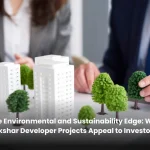
The Future of Sustainable Real Estate: How Green Homes and Eco-Friendly Practices Are Shaping Modern
The Future of Sustainable Real Estate: How Green Homes and Eco-Friendly Practices Are Shaping Modern
-
By Akshardevelopers_admin
-
November 5, 2024
-
Blog

As global challenges such as population growth, environmental degradation, and climate change continue to intensify, the real estate and construction industries have taken the lead in embracing sustainable practices. Implementing these practices not only benefits the environment but also provides economic and social gains. The rising demand for energy efficiency, green buildings, and healthier living environments has evolved from a trend to a necessity in modern society. This shift underscores the need for a deeper commitment to sustainability, ensuring a healthier world for future generations.
Building a Sustainable Future
The adoption of ‘Green Energy’ construction techniques is becoming increasingly prevalent. A report by Anarock highlights that green buildings can reduce energy consumption by 20-30% and water usage by 30-50%, making them an ideal long-term solution.
To foster environmental sustainability, several strategies can be employed, such as reducing energy usage during construction and implementing tree relocation programs. Developers are also turning to locally sourced materials, which not only reduce operational costs and transportation-related emissions but also significantly cut down on waste. The future of the industry holds the potential for increased use of recycled materials and non-toxic finishes, furthering eco-friendly construction practices.
Sustainability doesn’t end with the construction phase. Many developers are shifting toward renewable energy sources and focusing on sustainable architecture, design, and material efficiency. Modern buildings are designed to improve indoor air quality, optimize ventilation and natural lighting, and incorporate rainwater harvesting and solar energy systems.
Developers are also taking steps to install electric vehicle charging stations, solar-powered hot water systems, LED lighting, and organic waste management systems. These initiatives represent essential moves toward a more sustainable and environmentally responsible construction future.
Luxury Meets Sustainability
Today’s luxury real estate market is evolving, with both buyers and developers acknowledging the need to minimize their carbon footprint. In India, this shift toward sustainability has become a hallmark of high-end properties, driven by buyers who are environmentally conscious and well-traveled. These buyers recognize that luxury and sustainability can coexist, with their lifestyle choices reflecting a blend of opulence and environmental responsibility. Their homes, vehicles, and fashion choices reflect this new definition of luxury, which balances comfort with eco-friendly living.
In response to this demand, developers are increasingly investing in sustainable construction innovations. This transformation is reshaping the luxury real estate market in India, where lavish interiors, advanced amenities, and climate-friendly technologies redefine modern luxury living.
Green Homes
Green-certified homes are leading the charge toward a more sustainable future. These residences prioritize sustainability by incorporating energy-efficient systems, water conservation methods, and effective waste management practices. Beyond reducing environmental impact, green homes offer economic savings and improved well-being for residents, creating a win-win scenario for both people and the planet.
The Indian Green Building Council (IGBC) green homes certification is at the heart of this movement. This rating system assesses the environmental performance of residential buildings in India, blending traditional methods with new sustainability innovations.
The certification also emphasizes the health and well-being of occupants by enhancing indoor air quality and maximizing natural light. It serves as a tool for educating homeowners, builders, and the community on sustainable building practices, representing not just a standard, but a commitment to a greener, healthier future.
One of the major advantages of green homes is their cost-effectiveness in the long run. While upfront investments may be higher, homeowners soon realize savings on utilities such as water and electricity. As renewable technologies continue to advance and become more affordable, green homes are set to become even more financially feasible. Despite some challenges, net-zero buildings are on the horizon, poised to significantly benefit both the environment and public safety.
The real estate sector is on the cusp of a transformative revolution, with sustainable construction practices gaining traction not just in major cities but in smaller towns as well. Beyond environmental benefits, these practices offer substantial social, technological, and economic advantages. By embracing sustainable development, we are creating more resilient, environmentally conscious communities for the future.




